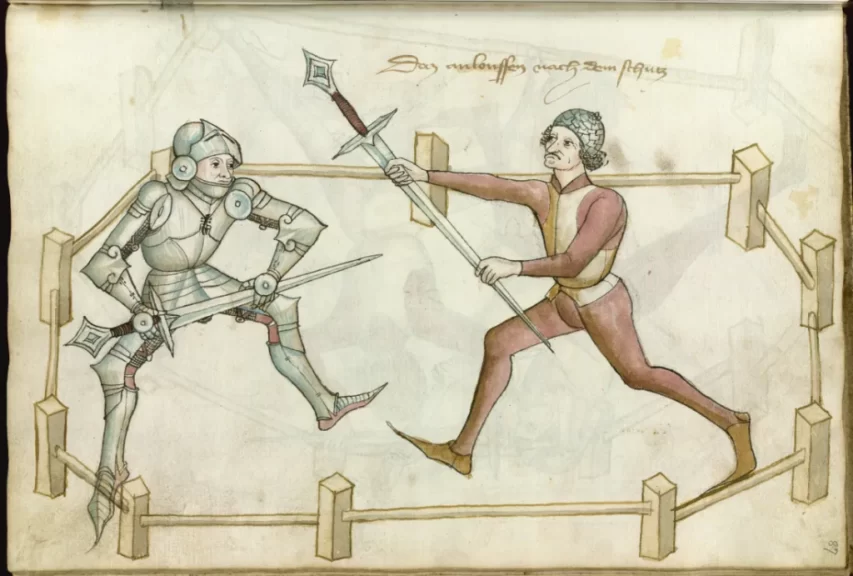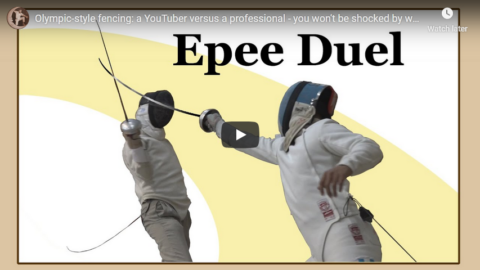I was for many years a member of the SCA partly for the attraction of the historical period and partly for the swordfighting. The Society developed a (mostly) safe simulation of (some) medieval combat styles and later introduced (some) renaissance rapier combat as well (initially borrowing equipment standards from modern sport fencing). Around the time the SCA began to consider expanding from high medieval sword-and-shield styles, separate organizations in Europe and the United States sprang up to be more consciously historical in how they recreated historical blade combat, these groups are often collectively referred to as Historical European Martial Arts (HEMA) or Western Martial Arts (WMA). The foundation documents for HEMA and other historical combat enthusiasts are the various surviving manuals of swordmasters and fencing school owners which cover a kaleidoscope of weapons, techniques, advice, and how-to illustrations … some of which appear to be physically impossible for ordinary human beings:
The ultimate experts in medieval sword fighting were the “fight masters” – elite athletes who trained their disciples in the subtle arts of close combat. The most highly renowned were almost as famous as the knights they trained, and many of the techniques they used were ancient, dating back hundreds of years in a continuous tradition.
Little is known about these rare talents, but the scraps of information that have survived are full of intrigue. Hans Talhoffer, a German fencing master with curly hair, impressive sideburns and a penchant for tight body suits, had a particularly chequered past. In 1434, he was accused of murdering a man and admitted abducting him in the Austrian city of Salzburg.
Fight masters worked with a grisly assortment of deadly weapons. The majority of training was dedicated to fencing with the longsword, or the sword and buckler (a style of combat involving holding a sword in one hand, and a small shield in the other). However, they also taught how to wield daggers, poleaxes, shields, and even how to fight with nothing at all, or just a bag of rocks (more on this later).
It’s thought that some fight masters were organised into brotherhoods, such as the Fellowship of Liechtenauer – a society of around 18 men who trained under the shadowy grandmaster Johannes Lichtenauer in the 15th Century. Though details about the almost-legendary figure himself have remained elusive, it’s thought he led an itinerant life, travelling across borders to train a handful of select proteges and learn new fencing secrets.
Other fight masters stayed closer to home – hired by dukes, archbishops and other assorted nobles to train themselves and their guards. A number even set up their own “fight schools”, where they gathered less wealthy students for regular weekly sessions.
[…]
For all their beauty, the hand-drawn works could also be decidedly bloodthirsty. In Talhoffer’s 1467 manual, neat sequences of moves that look almost like dancing end abruptly with swords through eye-sockets, violent impalings, and casual instructions to beat the opponent to death. Some signature techniques even have names – chilling titles like the “wrath-hew”, “crumpler”, “twain hangings”, “skuller” and “four openings”.
Despite passing through countless generations of owners, and – in some cases – centuries of graffiti, burns, theft, and mysterious periods of vanishment from the historical record, a surprising number survive today. This includes at least 80 codexes from German-speaking regions alone.
Impossible moves and missing clues
But there’s a problem. Many of the techniques in combat manuals, also known as “fechtbücher“, are convoluted, vague, and cryptic. Despite the large corpus of remaining books, they often offer surprisingly little insight into what the fight master is trying to convey.
“It’s famously difficult to take these static unmoving woodcut images, and determine the dynamic action of combat,” says Scott Nokes, “This has been a topic of debate, research and experimentation for generations.”
On some occasions these manuals seem to depict contortions of the body that are physically impossible, while those that attempt to convey moves in three dimensions sometimes give combatants extra arms and legs that were added in by accident. Others contain instructions that are frustratingly opaque – sometimes depicting actions that don’t seem to work, or building upon enigmatic moves that have long-since been lost.
Oddly, the text is often written as poetry, rather than prose – and a few authors even made it hard to interpret their works on purpose.
Lichtenauer recorded his instructions in obscure verses which remain almost incomprehensible today – one expert has gone so far as to call them “gibberish”. According to a contemporary fight master he trained, the grandmaster wrote in “secret words” to prevent them from being intelligible to anyone who didn’t value his art highly enough.
Even when it is possible to decipher what a combat manual is describing or demonstrating, some experts suspect that crucial contextual information is always missing.








